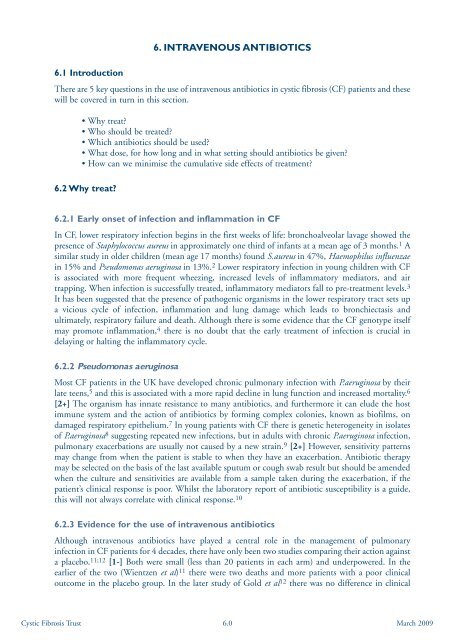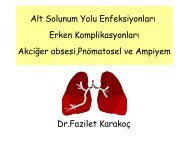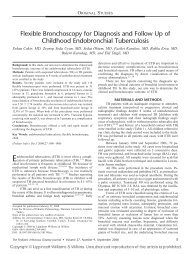69. Pitchford KC, Corey M, Highsmith AK, Perlman R, Bannatyne R, Gold R et al. Pseudomonas sp. contamination<strong>of</strong> cystic fibrosis patients’ home inhalation equipment. J Pediatr 1987;111:212–6.70. Dodd ME, Abbott J, Maddison J, Moorcr<strong>of</strong>t AJ, Webb AK. Effect <strong>of</strong> tonicity <strong>of</strong> nebulised colistin on chesttightness and pulmonary function in adults with cystic fibrosis. Thorax 1997;52:656–8.71. Roberts GW, Badock NR, Jarvinen AO. <strong>Cystic</strong> fibrosis inhalation <strong>the</strong>rapy: stability <strong>of</strong> a combinedsalbutamol/colistin solution. Aust J Hosp Pharm 1992;22:378–80.72. Kamin W, Schwabe A, Kramer I. Inhalation solutions: which one are allowed to be mixed? Physico-chemicalcompatibility <strong>of</strong> drug solutions in nebulizers. J Cyst Fibros 2006;5:205–13.73. Nikander K, Prince IR, Couchlin SR, Warren S, Taylor G. Mode <strong>of</strong> breathing- tidal or slow and deep-through <strong>the</strong>I-neb Adaptive aerosol delivery (AAD) system affects lung depostion <strong>of</strong> 99mTc-DTPA. Proceedings <strong>of</strong> Drug deliveryto <strong>the</strong> lungs 2006.74. Mullinger B, Sommerer K, Herpich C, et al. Inhalation <strong>the</strong>rapy can be improved in CF patients by controlling <strong>the</strong>breathing pattern during inspiration. J Cyst Fibros 2004;3:S65.75. Prince I, Dixon E, Agent P, Pryor P, Hodson ME. Evaluation <strong>of</strong> a guide breathing manoeuvre for nebulised<strong>the</strong>rapyin cystic fibrosis patients. Pediatr Pulmonol 2004;suppl 27:313.76. Dodd ME, Conway SP, Marsden RJ, Paul EA, Weller PH. Interaction between bronchodilators and nebuliserdevice in cystic fibrosis patients taking colistin using a Halolite adaptive aerosol device (AAD) system compared toa high output conventional nebuliser system. European <strong>Cystic</strong> <strong>Fibrosis</strong> Society Meeting, Genoa 2002.77. Marsden RJ, Conway SP, Dodd ME, Edenborough FP, Paul EA, Rigby AS et al. A multi-centre, randomised studycomparing <strong>the</strong> Halolite adaptive aerosol delivery (AAD) system with a high output nebuliser system in patientswith cystic fibrosis. European <strong>Cystic</strong> <strong>Fibrosis</strong> Society Meeting, Genoa 2002.78. Adeboyeku DU, Agent P, Jackson V, Hodson M. A double blind randomised study to compare <strong>the</strong> safety andtolerance <strong>of</strong> differing concentrations <strong>of</strong> nebulised colistin administered using <strong>the</strong> Halolite in cystic fibrosis patients.Pediatr Pulmonol 2001;suppl 22:288.79. Denyer J, Nikander K, Smith NJ. Adaptive Aerosol Delivery (AAD) technology. Expert Opin Drug Deliv2004;1:165– 76.80. Hardaker LE, Potter RW, Akunda EA. Delivery <strong>of</strong> tobramycin via <strong>the</strong> I-neb adaptive aerosol delivery (AAD) systemand <strong>the</strong> Pari LC Plus nebuliser. J Cyst Fibros 2006;5:s41.<strong>Cystic</strong> <strong>Fibrosis</strong> <strong>Trust</strong> 5.18March 2009
6.1 Introduction6. INTRAVENOUS ANTIBIOTICSThere are 5 key questions in <strong>the</strong> use <strong>of</strong> intravenous antibiotics in cystic fibrosis (CF) patients and <strong>the</strong>sewill be covered in turn in this section.• Why treat?• Who should be treated?• Which antibiotics should be used?• What dose, for how long and in what setting should antibiotics be given?• How can we minimise <strong>the</strong> cumulative side effects <strong>of</strong> treatment?6.2 Why treat?6.2.1 Early onset <strong>of</strong> infection and inflammation in CFIn CF, lower respiratory infection begins in <strong>the</strong> first weeks <strong>of</strong> life: bronchoalveolar lavage showed <strong>the</strong>presence <strong>of</strong> Staphylococcus aureus in approximately one third <strong>of</strong> infants at a mean age <strong>of</strong> 3 months. 1 Asimilar study in older children (mean age 17 months) found S.aureus in 47%, Haemophilus influenzaein 15% and Pseudomonas aeruginosa in 13%. 2 Lower respiratory infection in young children with CFis associated with more frequent wheezing, increased levels <strong>of</strong> inflammatory mediators, and airtrapping. When infection is successfully treated, inflammatory mediators fall to pre-treatment levels. 3It has been suggested that <strong>the</strong> presence <strong>of</strong> pathogenic organisms in <strong>the</strong> lower respiratory tract sets upa vicious cycle <strong>of</strong> infection, inflammation and lung damage which leads to bronchiectasis andultimately, respiratory failure and death. Although <strong>the</strong>re is some evidence that <strong>the</strong> CF genotype itselfmay promote inflammation, 4 <strong>the</strong>re is no doubt that <strong>the</strong> early treatment <strong>of</strong> infection is crucial indelaying or halting <strong>the</strong> inflammatory cycle.6.2.2 Pseudomonas aeruginosaMost CF patients in <strong>the</strong> <strong>UK</strong> have developed chronic pulmonary infection with P.aeruginosa by <strong>the</strong>irlate teens, 5 and this is associated with a more rapid decline in lung function and increased mortality. 6[2+] The organism has innate resistance to many antibiotics, and fur<strong>the</strong>rmore it can elude <strong>the</strong> hostimmune system and <strong>the</strong> action <strong>of</strong> antibiotics by forming complex colonies, known as bi<strong>of</strong>ilms, ondamaged respiratory epi<strong>the</strong>lium. 7 In young patients with CF <strong>the</strong>re is genetic heterogeneity in isolates<strong>of</strong> P.aeruginosa 8 suggesting repeated new infections, but in adults with chronic P.aeruginosa infection,pulmonary exacerbations are usually not caused by a new strain. 9 [2+] However, sensitivity patternsmay change from when <strong>the</strong> patient is stable to when <strong>the</strong>y have an exacerbation. <strong>Antibiotic</strong> <strong>the</strong>rapymay be selected on <strong>the</strong> basis <strong>of</strong> <strong>the</strong> last available sputum or cough swab result but should be amendedwhen <strong>the</strong> culture and sensitivities are available from a sample taken during <strong>the</strong> exacerbation, if <strong>the</strong>patient’s clinical response is poor. Whilst <strong>the</strong> laboratory report <strong>of</strong> antibiotic susceptibility is a guide,this will not always correlate with clinical response. 106.2.3 Evidence for <strong>the</strong> use <strong>of</strong> intravenous antibioticsAlthough intravenous antibiotics have played a central role in <strong>the</strong> management <strong>of</strong> pulmonaryinfection in CF patients for 4 decades, <strong>the</strong>re have only been two studies comparing <strong>the</strong>ir action againsta placebo. 11;12 [1-] Both were small (less than 20 patients in each arm) and underpowered. In <strong>the</strong>earlier <strong>of</strong> <strong>the</strong> two (Wientzen et al) 11 <strong>the</strong>re were two deaths and more patients with a poor clinicaloutcome in <strong>the</strong> placebo group. In <strong>the</strong> later study <strong>of</strong> Gold et al 12 <strong>the</strong>re was no difference in clinical<strong>Cystic</strong> <strong>Fibrosis</strong> <strong>Trust</strong> 6.0March 2009
- Page 3 and 4: 4. ORAL ANTIBIOTICS IN CYSTIC FIBRO
- Page 5 and 6: 7. OTHER INFECTIONS7.1 Management o
- Page 7 and 8: GRADING SCHEME FOR LEVELS OF EVIDEN
- Page 9 and 10: SUMMARY•All young children with c
- Page 11: In 1989 the Copenhagen centre recom
- Page 15 and 16: These bacteria can be harmless comm
- Page 17 and 18: 2.7 Clinical relevance of in vitro
- Page 19 and 20: 17. Macia MD, Blanquer D, Togores B
- Page 21 and 22: 3.1 Introduction3. IDENTIFICATION O
- Page 23 and 24: Table 2: Laboratory techniques and
- Page 25 and 26: 20. Hoppe JE, Theurer MU, Stern M.
- Page 27 and 28: 4.2.4 Recommendations for treatment
- Page 29 and 30: 4.5 Use of oral antibiotics at time
- Page 31 and 32: groups in terms of the chronic use
- Page 33 and 34: 5.1 Introduction5. NEBULISED ANTIBI
- Page 36 and 37: 5.5 Nebulised antibiotics to preven
- Page 38 and 39: 5.10.2 Recommendations for administ
- Page 40 and 41: • If a facemask is used the face
- Page 42 and 43: 5.16 Nebuliser/compressor systems f
- Page 44 and 45: 19. Ratjen F, Walter H, Haug M, Mei
- Page 48 and 49: outcome between active and placebo
- Page 50 and 51: Drug Route Age/weight DoseFrequency
- Page 52 and 53: much sooner. A minimum of 10-14 day
- Page 54 and 55: 6.8 References1. Armstrong DS, Grim
- Page 56 and 57: 7. OTHER INFECTIONS7.1 Management o
- Page 58 and 59: 7.2 Respiratory infection with meti
- Page 60 and 61: Table 7.2 Published data on eradica
- Page 62 and 63: 7.4.2 Recommendations• Given the
- Page 64 and 65: although not all authors have found
- Page 66 and 67: Table 7.3 Drugs for treatment of My
- Page 68 and 69: 7.9.2 Diagnosis of ABPAThe Cystic F
- Page 70 and 71: • It is important to assess the c
- Page 72 and 73: 12. Blackburn L, Brownlee K, Conway
- Page 74 and 75: 57. Ballestero S, Virseda I, Escoba
- Page 76 and 77: 107. Deerojanawong J, Sawyer SM, Fi
- Page 78 and 79: 155. Stevens DA, Moss RB, Kurup VP,
- Page 80 and 81: 8. PHARMACOPOEIAOriginally based on
- Page 82 and 83: 8.3 Treatment of more severe exacer
- Page 84 and 85: Co-amoxiclav orallyAge Dose Frequen
- Page 86 and 87: Cefotaxime intravenouslyAge Dose Fr
- Page 88 and 89: 8.7 Treatment of Pseudomonas aerugi
- Page 90 and 91: 8.8.3 Other ß-lactam antibioticsTh
- Page 92 and 93: Amikacin intravenouslyAge Dose Freq
- Page 94 and 95: 8.10 Chronic oral anti-pseudomonal
- Page 96 and 97:
TemocillinAge Dose Frequency>12year
- Page 98 and 99:
Liposomal Amphotericin (“Ambisome
- Page 100 and 101:
9. ANTIBIOTIC-RELATED ALLERGIES AND
- Page 102:
I N F O R M A T I O NCystic Fibrosi






